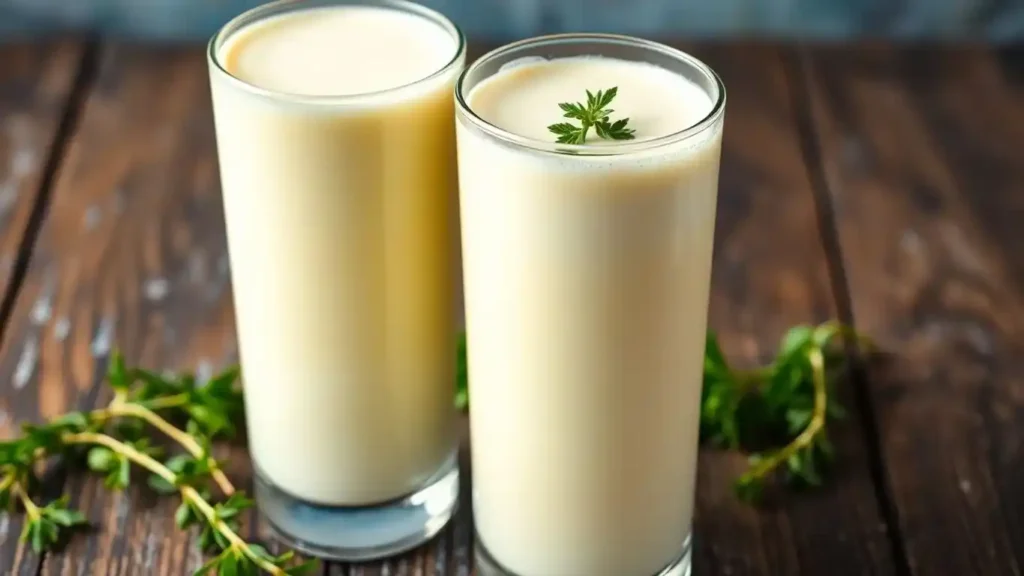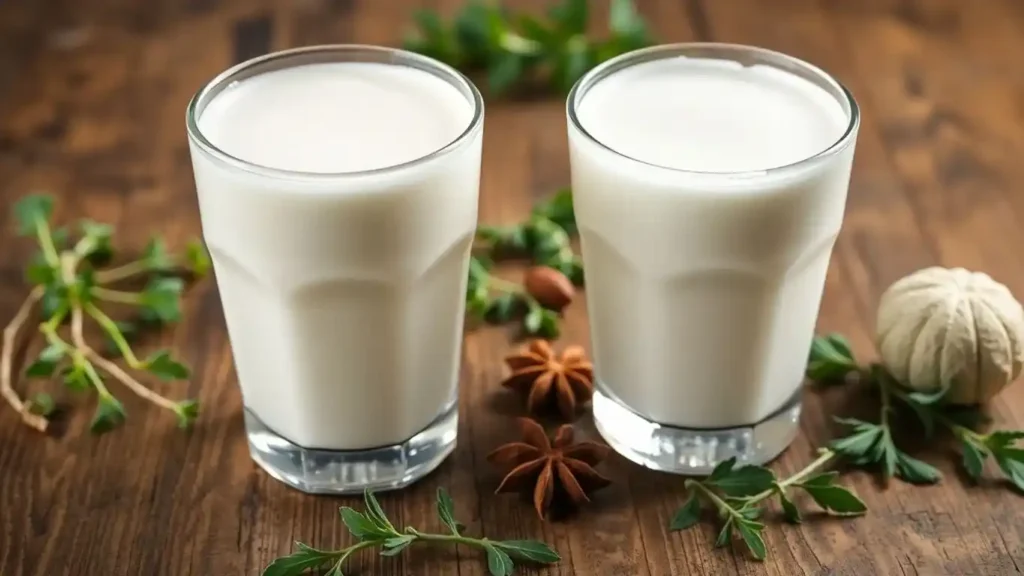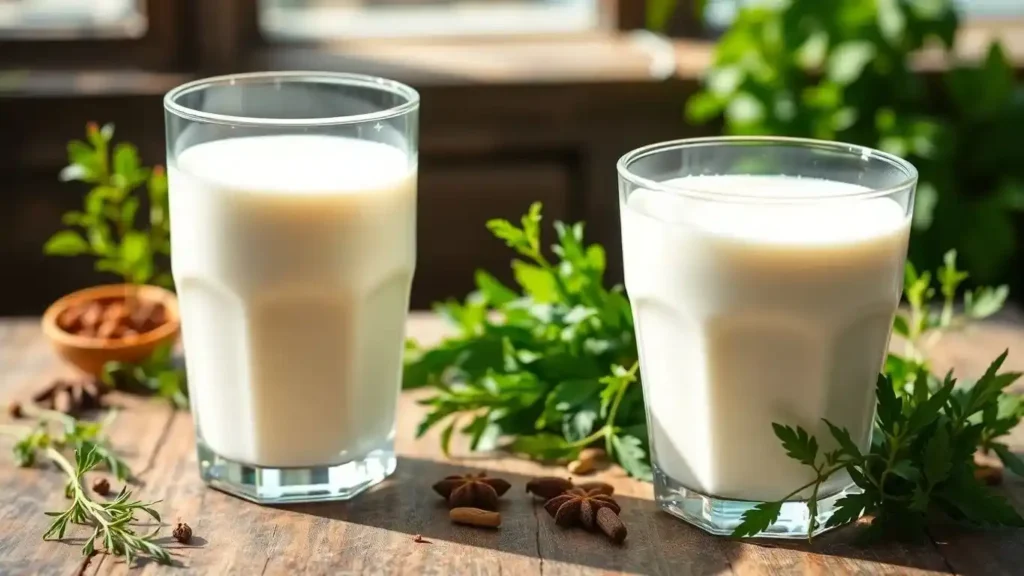Sour cream is a staple ingredient in many kitchens, adding richness and tang to baked goods, dressings, and dips. But what if you’re looking for a healthier alternative? Kefir, a fermented dairy drink packed with probiotics, has gained popularity as a substitute. But does it really compare to sour cream in terms of nutrition and functionality in recipes?
This article explores the nutritional differences between kefir and sour cream, their health benefits, and how they affect taste and texture in cooking and baking. Whether you’re looking for a lighter option, a probiotic boost, or simply want to experiment with new ingredients, we’ll help you determine if kefir is the right substitute for sour cream in your diet.
Which Has Better Nutritional Profiles: Buttermilk or Kefir?

Table of contents
Nutritional Composition of Buttermilk
buttermilk or kefir?, Buttermilk is a fermented dairy product rich in nutrients. It’s primarily composed of water, lactose, and casein, a high-quality milk protein. This drink is a great source of calcium, vitamin B12, and riboflavin, offering essential vitamins necessary for maintaining good health. Though buttermilk is low in fat, its protein content is noteworthy, making it beneficial for those looking to increase their protein intake.
Nutritional Composition of Kefir
Kefir, another fermented beverage, is renowned for its unique combination of beneficial bacteria, organic compounds, and amino acids. It boasts a higher protein content than buttermilk, providing about 2.7% protein. Kefir is also packed with essential vitamins like B1, B5, and C, and contains omega-6 fatty acids. The presence of lysine, an amino acid crucial for the central nervous system, makes kefir a standout choice for those seeking a nutrient-dense option.
Comparing Key Nutrients
When comparing buttermilk and kefir, there are some clear differences. Kefir generally has more protein and beneficial probiotics, which aid in gut health. It also contains a broader range of essential amino acids. While both drinks are low in fat, buttermilk tends to have a slightly lower fat content. For those interested in boosting their intake of probiotics and amino acids, kefir might be the better choice. However, buttermilk remains a solid option for those prioritizing calcium and riboflavin intake.
Which Has More Health Benefits: Buttermilk or Kefir?

Gut Health and Probiotics
Both buttermilk and kefir are rich in probiotics, which are known for their positive effects on digestive health. These fermented drinks introduce beneficial bacteria to your gut, potentially reducing the risk of digestive disorders. Buttermilk, with its lactic acid, is easier on the stomach for those with lactose intolerance. Kefir, on the other hand, is a probiotic powerhouse, containing multiple strains of bacteria and yeast. Regular consumption of these drinks can bolster your gut microbiome, possibly enhancing your overall health.
Bone Health and Calcium Content
Calcium is crucial for maintaining strong bones, and both buttermilk and kefir are excellent sources. A cup of buttermilk provides about 300 mg of calcium, helping to meet daily requirements and support bone density. Kefir not only offers calcium but also contains Vitamin K, which aids in calcium absorption and may reduce the risk of fractures. Including these drinks in your diet could be a tasty way to support bone health and prevent diseases like osteoporosis.
Weight Management and Metabolism
Incorporating buttermilk and kefir into your diet might assist with weight management. These low-calorie drinks can be a healthier alternative to sugary beverages. The high protein content in kefir can promote a feeling of fullness, potentially curbing overeating. Additionally, the probiotics in both drinks may positively influence metabolism, contributing to weight loss efforts. It’s a simple addition to your diet that can have multiple health benefits.
Differences in Taste and Texture Between Buttermilk and Kefir
Flavor Profiles of Buttermilk
Traditional buttermilk is a bit milder, with a smooth tanginess that brings a refreshing taste to the palate. It’s not as thick as heavy cream but has a richer texture than regular milk. The flavors are slightly sour but not overpowering, making it versatile for both drinking and cooking. Buttermilk’s unique taste comes from the lactic acid bacteria used in its fermentation process, which gives it that characteristic tang.
Flavor Profiles of Kefir
Kefir, on the other hand, is quite the flavor powerhouse. Its tangy and acidic notes are more pronounced than buttermilk, and it often has a slight fizz due to the natural fermentation process involving yeast. The longer kefir ferments, the stronger the flavors become. This makes kefir a bit of an acquired taste for some, but a delightful treat for those who enjoy robust, fermented flavors.
Texture and Consistency Comparison
When it comes to texture, buttermilk is thinner and creamier, similar to a light cream. In contrast, kefir is thicker, almost like a drinkable yogurt, but not as dense as heavy cream. The texture of kefir is also slightly bubbly, thanks to the carbon dioxide produced during fermentation. This effervescence adds a unique mouthfeel that buttermilk lacks. If you’re looking for a drink with a bit more body and fizz, kefir might be your go-to.
The choice between buttermilk and kefir often boils down to personal preference. Some love the mild tang of buttermilk, while others prefer the bold, fizzy kick of kefir. Whether you’re mixing it into your morning smoothie or using it in baking, understanding these differences can help you make the best choice for your taste buds.
Both buttermilk and kefir offer unique flavors and textures that can enhance a variety of dishes. From the traditional buttermilk’s smooth tanginess to kefir’s robust, fizzy profile, each has its own appeal. Whether you’re converting cream into butter or simply enjoying a refreshing drink, these fermented beverages are a testament to the diverse world of flavors and textures.
Incorporating Buttermilk and Kefir into Your Diet
Daily Consumption Guidelines
Incorporating buttermilk and kefir into your daily diet can be a simple yet effective way to boost your intake of probiotics and essential nutrients. Aim to consume one serving of either buttermilk or kefir daily, which can be easily achieved by adding them to your morning routine or as a snack. Both beverages are excellent sources of calcium, Vitamin B6, and other nutrients that support a healthy diet.
- Buttermilk: A cup of buttermilk can be a refreshing drink on its own or used as a base for smoothies. It’s a great way to increase your calcium and Vitamin B6 intake.
- Kefir: This drink can be enjoyed plain or flavored with fruits. It’s an excellent source of protein and fatty acids, making it a nutritious addition to any meal.
Creative Recipe Ideas
Buttermilk and kefir are versatile ingredients that can enhance the flavor and nutritional value of many dishes. Here are some ideas to get you started:
- Smoothies: Blend kefir with your favorite fruits and a handful of spinach for a nutrient-packed smoothie.
- Pancakes and Waffles: Use buttermilk in your pancake or waffle batter for a fluffy texture and tangy taste.
- Salad Dressings: Mix kefir with herbs and spices for a creamy, probiotic-rich salad dressing.
Potential Dietary Restrictions
While both buttermilk and kefir are generally considered healthy foods, they might not be suitable for everyone. Individuals with lactose intolerance should opt for lactose-free versions or consume them in moderation. Additionally, those monitoring their sodium intake should be cautious, as some commercial products may contain added sodium.
Incorporating these fermented drinks into your diet not only adds a unique flavor but also supports a balanced diet with their rich nutrient profile. They are an excellent source of probiotics, contributing to a healthy food environment and overall well-being.
The Fermentation Process: How Buttermilk and Kefir Are Made
Traditional Methods of Making Buttermilk
Buttermilk, originally a byproduct of butter churning, is now crafted through fermentation. Modern buttermilk involves adding lactic acid bacteria to low-fat milk. This process transforms the milk into a tangy, slightly thickened beverage. You can even make buttermilk at home by mixing regular milk with a bit of store-bought buttermilk and letting it sit at room temperature for 24-48 hours. For a quick fix, add lemon juice or vinegar to milk and let it curdle.
The Unique Fermentation of Kefir
Kefir, on the other hand, is a fermented milk drink made using milk kefir grains. These grains are a mix of bacteria and yeast, creating a symbiotic culture known as SCOBY. To make kefir, you simply add these grains to milk and let them ferment at room temperature for about 24 hours. The result is a tangy, slightly effervescent beverage that’s richer in probiotics than yogurt. Unlike buttermilk, the grains can be reused indefinitely, making kefir a long-term investment despite its higher initial cost.
Homemade vs. Store-Bought Options
Both buttermilk and kefir can be made at home, offering freshness and control over the fermentation process. Homemade versions allow you to avoid added sugars and preservatives often found in store-bought options. While buttermilk requires a starter from previous batches, kefir relies on the perpetual use of kefir grains. Store-bought buttermilk is typically pasteurized and homogenized, while kefir might be available in flavored varieties, though these can sometimes diminish the probiotic benefits. Making your own fermented foods at home can be a rewarding and cost-effective way to incorporate these nutritious drinks into your diet.
Buttermilk or Kefir: Cost and Accessibility
Price Comparison
When it comes to the cost of buttermilk and kefir, there are some notable differences. Buttermilk is generally more affordable than kefir, largely due to its simpler production process. In most grocery stores, a liter of buttermilk might cost you around $1.50, while kefir can be priced at approximately $3.00 per liter. This price difference is mainly because kefir requires special kefir grains for fermentation, which are not only more expensive but also less common than the bacteria used for buttermilk.
Availability in Stores
Buttermilk is widely available in most supermarkets, often found alongside other milk products. It’s a staple in many households, especially for those who enjoy baking. or making pancakes. Kefir, on the other hand, might be a bit trickier to find. While you can usually spot flavored kefir drinks in the dairy aisle, plain kefir might not be stocked in smaller stores. Larger supermarkets or health food stores are more likely to carry a variety of kefir options.
Making Your Own at Home
If you’re keen on DIY, both buttermilk and kefir can be made at home. To make buttermilk, all you need is some regular milk and a small amount of buttermilk to kickstart the fermentation. This process is straightforward and cost-effective, especially if you frequently use buttermilk in recipes. Making kefir at home requires a bit more effort. You’ll need to invest in kefir grains, which, though initially pricey, can be reused indefinitely if properly cared for. This makes homemade kefir a long-term economical choice, especially if you’re a regular milk drinker.
Whether you’re picking up a carton at the store or trying your hand at homemade versions, the choice between buttermilk and kefir often comes down to personal preference and dietary needs. Both offer unique flavors and health benefits, making them a valuable addition to any diet.
Buttermilk or Kefir: Which is Better for Lactose Intolerance?

Lactose Content in Buttermilk
Buttermilk is a popular choice among those who are lactose intolerant. The fermentation process breaks down lactose, making it easier to digest. This is because the lactic acid bacteria used in buttermilk production consume lactose, reducing its presence. For people who enjoy dairy products but struggle with lactose, buttermilk offers a more digestible option. Additionally, buttermilk is often made from low-fat milk, which can be beneficial for those watching their cholesterol levels.
Lactose Content in Kefir
Kefir is another fermented dairy product that is generally well-tolerated by those with lactose intolerance. The fermentation process in kefir is more extensive than in buttermilk, often resulting in even lower lactose levels. Kefir grains contain a mix of bacteria and yeasts that significantly reduce the lactose content. This makes kefir a suitable choice for individuals seeking to incorporate dairy into their diet without the discomfort associated with lactose.
Digestibility and Tolerance: Buttermilk or Kefir?
When comparing buttermilk and kefir, both have their benefits for lactose-intolerant individuals. However, kefir might have the edge due to its lower lactose content and higher probiotic count. These probiotics not only help in breaking down lactose but also support gut health, making kefir a robust option for those with digestive concerns. On the other hand, buttermilk, with its mild taste and lower fat content, is an excellent choice for those who prefer a lighter dairy option. Both can be incorporated into a low-fat diet, providing lean protein without the high-fat content typical of other dairy choices.
Conclusion
So, when it comes down to choosing between buttermilk and kefir, it really depends on what you’re looking for. Both are great for gut health, thanks to their probiotics. Buttermilk is a bit lighter, with less fat, making it a good choice if you’re watching your fat intake.
It’s also easier on the wallet if you’re making it at home. Kefir, on the other hand, packs a punch with more probiotics and a thicker texture, almost like a drinkable yogurt. It’s a bit more tangy and might take some getting used to, but it’s worth it for the gut benefits. Plus, once you have the kefir grains, you can keep making it indefinitely. So, whether you go for the mild taste of buttermilk or the tangy kick of kefir, both can be a healthy addition to your diet. Just remember, moderation is key!
Frequently Asked Questions
What are the main health benefits of buttermilk?
Buttermilk is low in fat and calories, making it a good choice for those watching their weight. It contains probiotics that help with digestion and is a good source of calcium, supporting strong bones.
How does kefir help with gut health?
Kefir is rich in probiotics, which are beneficial bacteria that support a healthy gut. These probiotics can improve digestion and help with lactose intolerance.
Which has more protein, buttermilk or kefir?
Kefir generally has more protein compared to buttermilk. It’s also packed with beneficial bacteria, making it a great choice for gut health.
Can people with lactose intolerance drink buttermilk or kefir?
Yes, both buttermilk and kefir have lower lactose levels due to fermentation, making them easier to digest for those with lactose intolerance.
What does kefir taste like?
Kefir has a tangy and sour taste, similar to yogurt but slightly more liquid. Its flavor can become stronger the longer it ferments.
Is it cheaper to make buttermilk or kefir at home?
Making buttermilk at home is generally cheaper because you only need milk and a bit of buttermilk to start. Kefir requires kefir grains, which can be more expensive initially but can be reused indefinitely.
